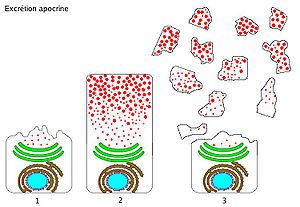
Apocrine
Encyclopedia

Apocrine is a term used to classify exocrine glands in the study of histology
Histology
Histology is the study of the microscopic anatomy of cells and tissues of plants and animals. It is performed by examining cells and tissues commonly by sectioning and staining; followed by examination under a light microscope or electron microscope...
. Cells which are classified as apocrine bud their secretions off through the plasma membrane producing membrane-bound vesicles in the lumen
Lumen (anatomy)
A lumen in biology is the inside space of a tubular structure, such as an artery or intestine...
. This method is also called decapitation secretion. The apical portion of the secretory cell of the gland pinches off and enters the lumen.
Apocrine secretion is less damaging to the gland than holocrine
Holocrine
Holocrine is a term used to classify the mode of secretion in exocrine glands in the study of histology. Holocrine secretions are produced in the cytoplasm of the cell and released by the rupture of the plasma membrane, which destroys the cell and results in the secretion of the product into the...
secretion (which destroys a cell) but more damaging than merocrine
Merocrine
Merocrine is a term used to classify exocrine glands and their secretions in the study of histology. A cell is classified as merocrine if the secretions of that cell are excreted via exocytosis from secretory cells into an epithelial-walled duct or ducts and thence onto a bodily surface or into the...
secretion (exocytosis
Exocytosis
Exocytosis , also known as 'The peni-cytosis', is the durable process by which a cell directs the contents of secretory vesicles out of the cell membrane...
).
Apocrine sweat glands are not true apocrine glands; it is now known that they use merocrine
Merocrine
Merocrine is a term used to classify exocrine glands and their secretions in the study of histology. A cell is classified as merocrine if the secretions of that cell are excreted via exocytosis from secretory cells into an epithelial-walled duct or ducts and thence onto a bodily surface or into the...
secretion. The name is maintained for historical reasons.
An example of true apocrine glands are mammary glands, responsible for secreting breast milk.
Apocrine metaplasia
Apocrine metaplasia is a reversible transformation of cells to an apocrine phenotypePhenotype
A phenotype is an organism's observable characteristics or traits: such as its morphology, development, biochemical or physiological properties, behavior, and products of behavior...
. It is common in the breast in the context of fibrocystic change
Fibrocystic breast changes
Fibrocystic breast changes or fibrocystic breast disease is a condition of breast tissue affecting an estimated 30-60% of women. It is characterized by noncancerous breast lumps in the breast which can sometimes cause discomfort, often periodically related to hormonal influences from the menstrual...
.

